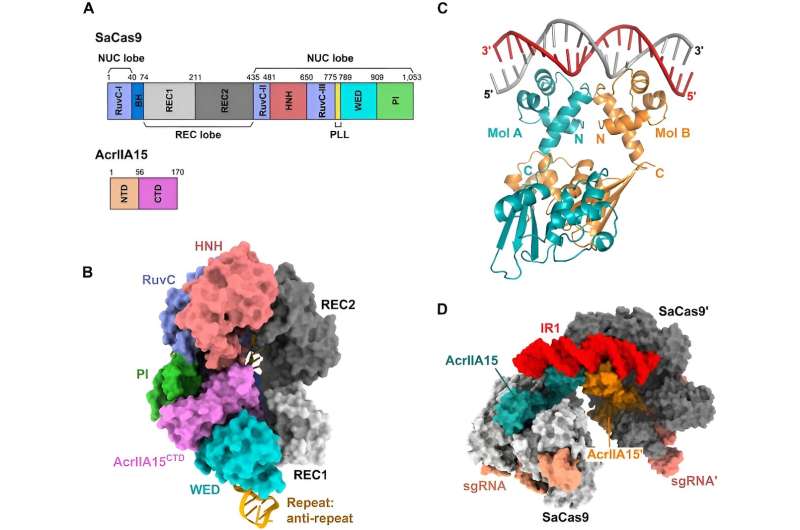This article has been reviewed according to Science X's editorial process and policies. Editors have highlighted the following attributes while ensuring the content's credibility:
fact-checked
trusted source
proofread
Researchers reveal dual-function mechanism of bacteriophage-derived protein AcrIIA15

In response to the efficient attacks of the host CRISPR-Cas system, bacteriophages have evolved various resistance strategies, including encoding anti-CRISPR (Acr) proteins. Since their initial discovery in 2013, over a hundred Acr proteins have been identified. These proteins use different mechanisms to inhibit the recognition and cleavage of target nucleic acids by the Cas protein-RNA complex, and have great potential for development as gene editing regulatory elements.
In a study published
in Nature Communications, a research team led by Prof. Wang Yanli from the Institute of Biophysics of the Chinese Academy of Sciences has revealed the dual-function mechanism of the Staphylococcus phage-derived Acr
AcrIIA15 contains two structural domains, the N-terminal and C-terminal domains (CTDs). The researchers resolved the electron microscopic structure of the SaCas9, guide RNA, and AcrIIA15 CTD ternary complex and showed that the AcrIIA15 surface has a strong negative charge, mimicking double-stranded DNA in both charge and shape to inhibit Cas9 from recognizing the target DNA.
Furthermore, AcrIIA15 also functions as a transcriptional repressor. By analyzing a series of crystal structures of AcrIIA15 with the inverted repeat sequence, it was found that NTD can mediate AcrIIA15 to form a dimer. In addition, the researchers experimentally verified the in vivo transcriptional repression function of AcrIIA15 using fluorescent protein reporters.
The regulation of transcriptional repression by Acr proteins is essential for the complete life cycle of bacteriophages. This study finally resolved the electron microscopic structure of the AcrIIA15 dimer bound to both the Cas9-sgRNA and the inverted repeat sequence, providing a panoramic view of how AcrIIA15 achieves dual inhibition at the molecular level.
This work enhances our understanding of Acr inhibition mechanisms and provides structural biological support for the potential development of AcrIIA15 as a gene editing regulatory tool in the future.
More information: Xieshuting Deng et al, An anti-CRISPR that represses its own transcription while blocking Cas9-target DNA binding, Nature Communications (2024). DOI: 10.1038/s41467-024-45987-5
Provided by Chinese Academy of Sciences




















